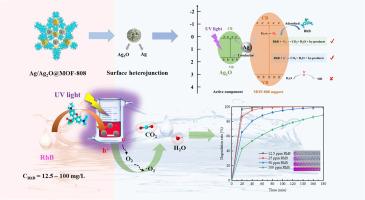结构稳定的Ag/Ag2O@MOF-808光催化剂高效光降解高浓度罗丹明B
IF 4.7
3区 化学
Q2 CHEMISTRY, PHYSICAL
Journal of Photochemistry and Photobiology A-chemistry
Pub Date : 2025-09-18
DOI:10.1016/j.jphotochem.2025.116789
引用次数: 0
摘要
开发稳定、高效的mof基光催化剂是处理高强度染料废水的必要条件。本文采用低温浸渍煅烧法制备了Ag/Ag2O@MOF-808表面异质结光催化剂。综合结构分析(XRD, FT-IR, SEM, TEM, BET, H2-TPR, XPS)证实了MOF-808成功加载银而没有损坏框架。通过调节焙烧温度,引入Ag0和Ag2O与MOF-808形成表面异质结。UV-vis DRS和价带XPS表明,Ag2O减小了带隙和价带位置,改善了光吸收和电荷分离。优化后的催化剂(质量分数为10 wt% Ag,温度为150°C)对罗丹明B (25 mg/L)的降解效率在60 min内达到98.1%,在100 mg/L下降解效率在180 min内达到88.8%。经过4次循环,该催化剂的Ag+浸出率为0.417%,活性保持率超过73%。自由基清除实验发现超氧自由基是主要的活性物质。性能的增强是由于Ag2O作为活性相,Ag0作为导电桥,MOF-808作为稳定载体的协同作用。这项工作为有效光催化降解废水中的有害染料提供了一种可控的、无氧化剂的策略。本文章由计算机程序翻译,如有差异,请以英文原文为准。

Structurally stable Ag/Ag2O@MOF-808 photocatalysts for efficient photodegradation of high-concentration Rhodamine B
The development of stable and efficient MOF-based photocatalysts is essential for the treatment of high-strength dye wastewater. In this study, Ag/Ag2O@MOF-808 surface heterojunction photocatalysts were synthesized by a low-temperature impregnation calcination method. Comprehensive structural analyses (XRD, FT-IR, SEM, TEM, BET, H2-TPR, XPS) confirmed successful silver loading without damaging the MOF-808 framework. By adjusting the calcination temperature, both Ag0 and Ag2O were introduced to form surface heterojunctions with MOF-808. UV–vis DRS and valence band XPS showed that Ag2O reduced the band gap and valence band position, improving light absorption and charge separation. The optimized catalyst (10 wt% Ag, 150 °C) achieved 98.1 % degradation of Rhodamine B (25 mg/L) under UV light within 60 min and maintained 88.8 % efficiency (within 180 min) at 100 mg/L. The catalyst exhibited excellent reusability with 0.417 % Ag+ leaching and over 73 % activity retention after four cycles. Radical scavenging experiments identified superoxide radicals as the dominant reactive species. The enhanced performance is attributed to the synergistic effect of Ag2O as the active phase, Ag0 as a conductive bridge, and MOF-808 as a stable support. This work offers a controllable, oxidant-free strategy for efficient photocatalytic degradation of hazardous dyes in wastewater.
求助全文
通过发布文献求助,成功后即可免费获取论文全文。
去求助
来源期刊
CiteScore
7.90
自引率
7.00%
发文量
580
审稿时长
48 days
期刊介绍:
JPPA publishes the results of fundamental studies on all aspects of chemical phenomena induced by interactions between light and molecules/matter of all kinds.
All systems capable of being described at the molecular or integrated multimolecular level are appropriate for the journal. This includes all molecular chemical species as well as biomolecular, supramolecular, polymer and other macromolecular systems, as well as solid state photochemistry. In addition, the journal publishes studies of semiconductor and other photoactive organic and inorganic materials, photocatalysis (organic, inorganic, supramolecular and superconductor).
The scope includes condensed and gas phase photochemistry, as well as synchrotron radiation chemistry. A broad range of processes and techniques in photochemistry are covered such as light induced energy, electron and proton transfer; nonlinear photochemical behavior; mechanistic investigation of photochemical reactions and identification of the products of photochemical reactions; quantum yield determinations and measurements of rate constants for primary and secondary photochemical processes; steady-state and time-resolved emission, ultrafast spectroscopic methods, single molecule spectroscopy, time resolved X-ray diffraction, luminescence microscopy, and scattering spectroscopy applied to photochemistry. Papers in emerging and applied areas such as luminescent sensors, electroluminescence, solar energy conversion, atmospheric photochemistry, environmental remediation, and related photocatalytic chemistry are also welcome.

 求助内容:
求助内容: 应助结果提醒方式:
应助结果提醒方式:


